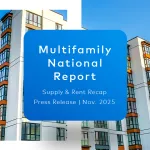Read the latest Yardi Matrix National Multifamily Market Report.
Report highlights:
- The average U.S. advertised asking rent fell for the second consecutive month in September, down $3 to $1,750, unchanged year-over-year at 0.9%.
- Lifestyle segment drove rent decline, Renter-by-Necessity rents remain flat.
- Supply growth commands rent performance as economic conditions recalibrate.
- SFR advertised asking rents slid $3 to $2,167, occupancy drops 30 basis points to 95.3% in August.
Economic progress sparks optimism across the multifamily market
The average U.S. advertised asking rent dropped by another $3 to $1,750 in September, but year-over-year growth remained flat at 0.9%, and occupancy at 94.8% for the fourth consecutive month. The 50-basis-point interest rate cut in September and strong employment numbers contributed to revived optimism about industry fundamentals. Rent growth is mainly driven by ongoing supply growth, and Yardi Matrix found that of the top 30 metros, rent growth was positive in eight of the 10 metros with the least supply growth, and negative in eight of the top 10 metros with the most supply growth.
Gateway metros in the East and secondary markets in the Midwest continued to lead rent growth, with New York City (5.4% year-over-year), Kansas City (4.2%), Boston (3.4%), Indianapolis (3.3%) and Washington, D.C. (3.1%) ranking highest. Conversely, the largest rent declines were recorded in Austin (-4.9%), Raleigh (-3.1%), Phoenix (-2.4%), Tampa (-2.3%) and Charlotte (-2.1%).
The rent decline was solely caused by a 0.3% month-over-month drop in the Lifestyle segment, while Renter-By-Necessity rents remained flat. New York (0.9%), Philadelphia (0.6%) and Indianapolis (0.5%) posted the largest RBN gains, while Detroit (1.3%), Indianapolis (1.0%), Baltimore and San Francisco (both 0.4%) led in Lifestyle rent increases.
Occupancy-absorption balance point to steady demand
The national occupancy rate remained at 94.8% in September, flat year-over-year. While the majority of markets had occupancy in the -0.2% to 0.2% band, several outperformed, led by Las Vegas (1.2% to 93.8%), Detroit and Portland (both 0.5%).
Post-pandemic, demand was sustained by economic and employment growth, immigration and demographics. Absorption illustrates it well, as all 132 markets surveyed posted positive absorption, for a total of 1.7 million multifamily units (10.8% of total stock) between March 2020 and August 2024. Dallas (108,000 units), Houston (71,000 units) and Washington, D.C. (60,000 units) led the ranking, followed by markets in the 44,000-49,000-unit bracket such as Denver, Austin, Phoenix, Orlando and Northern New Jersey. So far this year, 300,000 units have been absorbed nationally.
SFR advertised asking rents slid down $3 to $2,167 in September, with growth moderating to 0.6% year-over-year. Occupancy declined 0.3% year-over-year in August but remained healthy at 95.3%. Rent growth was highest in Kansas City (4.7%), Indianapolis (4.3%), Columbus (3.8%), Chicago (3.4%) and Detroit (2.6%). Declines were recorded in markets with low occupancy rates, including Phoenix (-3.8%, 92.6% occupancy), Jacksonville (-2.9%, 90.9%) and Austin (-2.7%, 90.8%).
Read the full Yardi Matrix Multifamily National Market Report: September 2024.











Add Comment